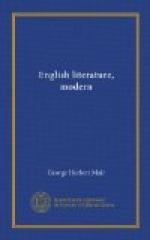This quality of egotism Lamb shares with other writers of the time, with De Quincey, for instance, who left buried in work which is extensive and unequal, much that lives by virtue of the singular elaborateness and loftiness of the style which he could on occasion command. For the revival of enthusiasm one must turn to Hazlitt, who brought his passionate and combative disposition to the service of criticism, and produced a series of studies remarkable for their earnestness and their vigour, and for the essential justness which they display despite the prejudice on which each of them was confessedly based.
CHAPTER VIII
THE VICTORIAN AGE
(1)
Had it not been that with two exceptions all the poets of the Romantic Revival died early, it might be more difficult to draw a line between their school and that of their successors than it is. As it happened, the only poet who survived and wrote was Wordsworth, the oldest of them all. For long before his death he did nothing that had one touch of the fire and beauty of his earlier work. The respect he began, after a lifetime of neglect, to receive in the years immediately before his death, was paid not to the conservative laureate of 1848, but to the revolutionary in art and politics of fifty years before. He had lived on long after his work was done
“To hear the world applaud the hollow ghost
That blamed the living man.”
All the others, Keats, Shelley, Byron were dead before 1830, and the problem which might have confronted us had they lived, of adult work running counter to the tendencies and ideals of youth, does not exist for us. Keats or Shelley might have lived as long as Carlyle, with whom they were almost exactly contemporary; had they done so, the age of the Romantic Revival and the Victorian age would have been united in the lives of authors who were working in both. We should conceive that is, the whole period as one, just as we conceive of the Renaissance in England, from Surrey to Shirley, as one. As it is, we have accustomed ourselves to a strongly marked line of




